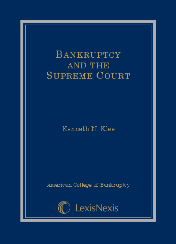 RN post. The download consist of an excerpt from chapter 1 on Supreme Court Justices papers:
RN post. The download consist of an excerpt from chapter 1 on Supreme Court Justices papers:After 7 years, Ken Klee has completed his book on Bankruptcy and the United States Supreme Court. This 6 chapter book is a comprehensive desk reference for lawyers, judges, and scholars examining the Supreme Court's bankruptcy decisions from 1898 through 2008 from six different perspectives. Chapter 1 examines the Court as a governmental and political institution devoting attention to the Court's business and habits, i.e., the processes by which the Court receives bankruptcy cases and decides them and the rules it promulgates to regulate bankruptcy courts and practice.
Chapter 2 looks at how the Court tends to resolve conflicts between bankruptcy law and other areas of state and federal law, such as administrative law, family law, labor law, pension law, probate law, real estate law, and tax law. This discussion is linked closely to Chapter 3 which discusses the constitutional breadth of the bankruptcy power and analyzes how the Court reconciles bankruptcy law with constitutional law, sovereign immunity, federal preemption, and federalism, as well as the use of state law in bankruptcy.
Chapter 4 discusses the Court's treatment of the bankruptcy court as a judicial institution. In particular, it examines how the Court has sculpted and restricted the bankruptcy court's subject matter jurisdiction, powers of the bankruptcy court, and res judicata and collateral estoppel effects of bankruptcy court and non-bankruptcy court judgments.
Chapter 5 analyzes, in considerable detail, bankruptcy law, doctrine, and policies that arise primarily or exclusively of the context of the Bankruptcy Code, such as avoiding powers, dischargeability, claims priority and distribution, and plan confirmation.
Chapter 6 discusses some of the bankruptcy cases over the past 111 years in which the Court sharply changed the course of bankruptcy law. It also includes some favorite cases, regardless of their impact on bankruptcy law or doctrine.
Chapter 2 looks at how the Court tends to resolve conflicts between bankruptcy law and other areas of state and federal law, such as administrative law, family law, labor law, pension law, probate law, real estate law, and tax law. This discussion is linked closely to Chapter 3 which discusses the constitutional breadth of the bankruptcy power and analyzes how the Court reconciles bankruptcy law with constitutional law, sovereign immunity, federal preemption, and federalism, as well as the use of state law in bankruptcy.
Chapter 4 discusses the Court's treatment of the bankruptcy court as a judicial institution. In particular, it examines how the Court has sculpted and restricted the bankruptcy court's subject matter jurisdiction, powers of the bankruptcy court, and res judicata and collateral estoppel effects of bankruptcy court and non-bankruptcy court judgments.
Chapter 5 analyzes, in considerable detail, bankruptcy law, doctrine, and policies that arise primarily or exclusively of the context of the Bankruptcy Code, such as avoiding powers, dischargeability, claims priority and distribution, and plan confirmation.
Chapter 6 discusses some of the bankruptcy cases over the past 111 years in which the Court sharply changed the course of bankruptcy law. It also includes some favorite cases, regardless of their impact on bankruptcy law or doctrine.